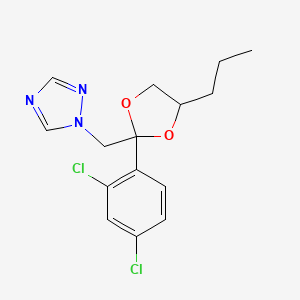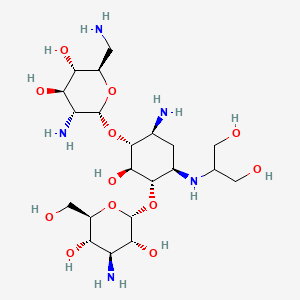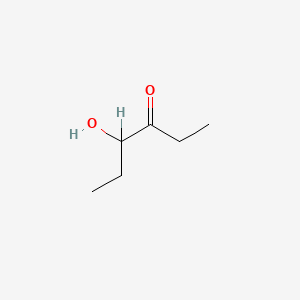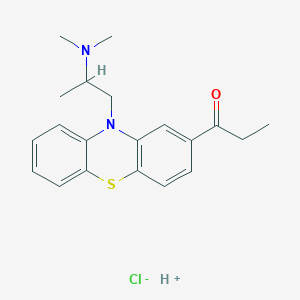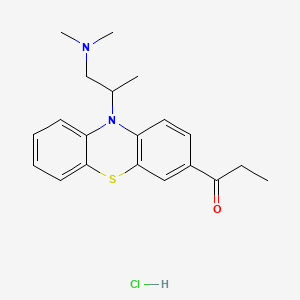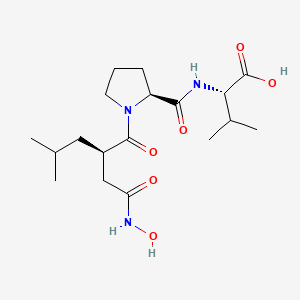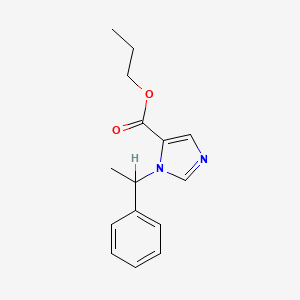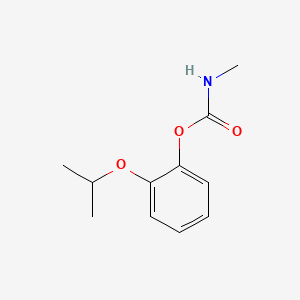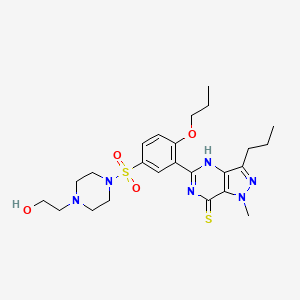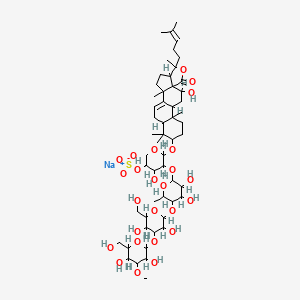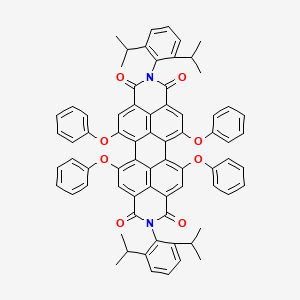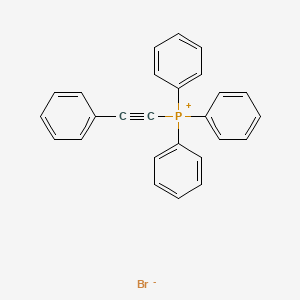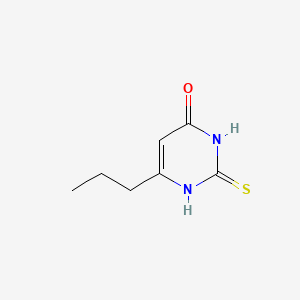
Propylthiouracil
Übersicht
Beschreibung
Propylthiouracil: ist ein Thioharnstoff-Antithyroidikum, das hauptsächlich zur Behandlung von Hyperthyreose eingesetzt wird, einschließlich Erkrankungen wie Morbus Basedow und toxischem multinodulärem Kropf . Es wirkt, indem es die Synthese von Schilddrüsenhormonen hemmt und die Umwandlung von Thyroxin (T4) in Trijodthyronin (T3) blockiert . This compound wird seit den 1940er Jahren medizinisch eingesetzt und ist in der Liste der unentbehrlichen Arzneimittel der Weltgesundheitsorganisation aufgeführt .
Herstellungsmethoden
Synthetische Routen und Reaktionsbedingungen: this compound kann durch Reaktion von Thioharnstoff mit Propyljodid in Gegenwart einer Base synthetisiert werden . Die Reaktion beinhaltet typischerweise das Erhitzen der Reaktanten unter Rückflussbedingungen, um die Bildung des gewünschten Produkts zu ermöglichen.
Industrielle Produktionsmethoden: Die industrielle Produktion von this compound beinhaltet ähnliche Syntheserouten, jedoch in größerem Maßstab. Der Prozess beinhaltet die Reinigung des Endprodukts durch Umkristallisation, um eine hohe Reinheit und Qualität zu gewährleisten .
Wirkmechanismus
Target of Action
Propylthiouracil primarily targets the thyroid peroxidase enzyme . This enzyme plays a crucial role in the synthesis of thyroid hormones, thyroxine (T4) and triiodothyronine (T3), by aiding in the incorporation of iodine into the thyroglobulin protein .
Mode of Action
This compound works by binding to thyroid peroxidase , thereby inhibiting the conversion of iodide to iodine . This interaction prevents the normal interactions of iodine and peroxidase with thyroglobulin, which are necessary for the formation of T4 and T3 . As a result, the production of thyroid hormones is decreased .
Biochemical Pathways
The primary biochemical pathway affected by this compound is the synthesis of thyroid hormones . By inhibiting thyroid peroxidase, this compound disrupts the iodination of tyrosine residues on thyroglobulin, a critical step in the synthesis of T4 and T3 . This leads to a decrease in the production of these hormones .
Pharmacokinetics
This compound is rapidly absorbed from the gastrointestinal tract, with a bioavailability of 80%-95% . It is metabolized by the liver and primarily excreted in the urine as metabolites . The elimination half-life of this compound is approximately 2 hours .
Result of Action
The primary result of this compound’s action is a decrease in the production of thyroid hormones, leading to a reduction in the symptoms of hyperthyroidism . By blocking the production of T4 and T3 in the thyroid gland, this compound helps to regulate the body’s metabolism, heart rate, growth, and weight .
Action Environment
The efficacy and stability of this compound can be influenced by various environmental factors. For instance, the presence of other medications can affect its absorption, distribution, metabolism, and excretion . Additionally, individual patient characteristics, such as age, sex, and overall health status, can also impact the drug’s effectiveness .
Wissenschaftliche Forschungsanwendungen
Chemie: Propylthiouracil wird als Modellverbindung in Studien verwendet, die Thioharnstoffderivate und ihre chemischen Eigenschaften betreffen .
Biologie: In der biologischen Forschung wird this compound verwendet, um die Synthese und den Metabolismus von Schilddrüsenhormonen zu untersuchen .
Medizin: this compound wird umfassend zur Behandlung von Hyperthyreose und Thyreotoxikose eingesetzt. Es wird auch in der Forschung verwendet, um die Mechanismen der Schilddrüsenhormonregulation zu verstehen .
Industrie: In der pharmazeutischen Industrie wird this compound in der Formulierung von Medikamenten für Schilddrüsenstörungen eingesetzt .
Wirkmechanismus
This compound übt seine Wirkung aus, indem es das Enzym Thyreoperoxidase hemmt, das für die Jodierung von Tyrosinresten in Thyreoglobulin entscheidend ist, ein wichtiger Schritt bei der Synthese von Schilddrüsenhormonen . Zusätzlich hemmt es die periphere Umwandlung von Thyroxin (T4) in Trijodthyronin (T3), wodurch die Gesamtkonsentration aktiver Schilddrüsenhormone im Körper reduziert wird .
Biochemische Analyse
Biochemical Properties
Propylthiouracil plays a significant role in biochemical reactions. It inhibits the synthesis of thyroxine and blocks the peripheral conversion of thyroxine to tri-iodothyronine . This is achieved by binding to thyroid peroxidase, an enzyme that normally aids in the incorporation of iodine into the thyroglobulin protein to form thyroid hormones .
Cellular Effects
This compound exerts various effects on cells and cellular processes. It decreases the amount of thyroid hormone produced by the thyroid gland, thereby influencing cell function . This includes impacts on cell signaling pathways, gene expression, and cellular metabolism .
Molecular Mechanism
The molecular mechanism of this compound involves its binding to thyroid peroxidase, thereby inhibiting the conversion of iodide to iodine . This action decreases thyroid hormone production and also interferes with the conversion of thyroxine (T4) to triiodothyronine (T3), reducing the activity of thyroid hormones .
Temporal Effects in Laboratory Settings
In laboratory settings, the effects of this compound change over time. For instance, a study showed that a 16-hour treatment with this compound was able to stimulate pregnenolone production in rat granulosa cells
Dosage Effects in Animal Models
The effects of this compound vary with different dosages in animal models. For instance, one study demonstrated that this compound, when supplemented with a low dose of levothyroxine, restored the this compound-induced reduction in the serum levels of T3 and T4 in rats .
Metabolic Pathways
This compound is involved in the metabolic pathway of thyroid hormone production. It inhibits the synthesis of thyroxine and blocks the peripheral conversion of thyroxine to tri-iodothyronine .
Transport and Distribution
This compound is readily absorbed and extensively metabolized. Approximately 35% of the drug is excreted in the urine, in intact and conjugated forms, within 24 hours .
Subcellular Localization
Given its mechanism of action, it is likely that this compound interacts with thyroid peroxidase, an enzyme located in the thyroid gland .
Vorbereitungsmethoden
Synthetic Routes and Reaction Conditions: Propylthiouracil can be synthesized through the reaction of thiourea with propyl iodide in the presence of a base . The reaction typically involves heating the reactants under reflux conditions to facilitate the formation of the desired product.
Industrial Production Methods: Industrial production of this compound involves similar synthetic routes but on a larger scale. The process includes the purification of the final product through recrystallization to ensure high purity and quality .
Analyse Chemischer Reaktionen
Arten von Reaktionen:
Oxidation: Propylthiouracil kann Oxidationsreaktionen eingehen, die zur Bildung von Disulfidbrücken führen.
Reduktion: Es kann zu seinem entsprechenden Thiol-Derivat reduziert werden.
Substitution: this compound kann an Substitutionsreaktionen teilnehmen, insbesondere an nukleophilen Substitutionen.
Häufige Reagenzien und Bedingungen:
Oxidation: Wasserstoffperoxid oder andere Oxidationsmittel.
Reduktion: Reduktionsmittel wie Natriumborhydrid.
Substitution: Nukleophile wie Amine oder Alkohole.
Hauptprodukte, die gebildet werden:
Oxidation: Disulfid-Derivate.
Reduktion: Thiol-Derivate.
Substitution: Verschiedene substituierte Thiouracil-Derivate.
Vergleich Mit ähnlichen Verbindungen
Ähnliche Verbindungen:
Methimazol: Ein weiteres Antithyroidikum, das zur Behandlung von Hyperthyreose eingesetzt wird.
Carbimazol: Ein Prodrug, das im Körper in Methimazol umgewandelt wird.
Vergleich:
Methimazol: Im Gegensatz zu Propylthiouracil hemmt Methimazol die periphere Umwandlung von T4 in T3 nicht.
This compound ist einzigartig in seiner doppelten Wirkung, sowohl die Schilddrüsenhormonsynthese als auch die periphere Umwandlung zu hemmen, wodurch es besonders bei akuten Thyreotoxikosen nützlich ist .
Eigenschaften
IUPAC Name |
6-propyl-2-sulfanylidene-1H-pyrimidin-4-one | |
|---|---|---|
| Source | PubChem | |
| URL | https://pubchem.ncbi.nlm.nih.gov | |
| Description | Data deposited in or computed by PubChem | |
InChI |
InChI=1S/C7H10N2OS/c1-2-3-5-4-6(10)9-7(11)8-5/h4H,2-3H2,1H3,(H2,8,9,10,11) | |
| Source | PubChem | |
| URL | https://pubchem.ncbi.nlm.nih.gov | |
| Description | Data deposited in or computed by PubChem | |
InChI Key |
KNAHARQHSZJURB-UHFFFAOYSA-N | |
| Source | PubChem | |
| URL | https://pubchem.ncbi.nlm.nih.gov | |
| Description | Data deposited in or computed by PubChem | |
Canonical SMILES |
CCCC1=CC(=O)NC(=S)N1 | |
| Source | PubChem | |
| URL | https://pubchem.ncbi.nlm.nih.gov | |
| Description | Data deposited in or computed by PubChem | |
Molecular Formula |
C7H10N2OS | |
| Source | PubChem | |
| URL | https://pubchem.ncbi.nlm.nih.gov | |
| Description | Data deposited in or computed by PubChem | |
DSSTOX Substance ID |
DTXSID5021209 | |
| Record name | 6-Propyl-2-thiouracil | |
| Source | EPA DSSTox | |
| URL | https://comptox.epa.gov/dashboard/DTXSID5021209 | |
| Description | DSSTox provides a high quality public chemistry resource for supporting improved predictive toxicology. | |
Molecular Weight |
170.23 g/mol | |
| Source | PubChem | |
| URL | https://pubchem.ncbi.nlm.nih.gov | |
| Description | Data deposited in or computed by PubChem | |
Physical Description |
Solid | |
| Record name | Propylthiouracil | |
| Source | Human Metabolome Database (HMDB) | |
| URL | http://www.hmdb.ca/metabolites/HMDB0014690 | |
| Description | The Human Metabolome Database (HMDB) is a freely available electronic database containing detailed information about small molecule metabolites found in the human body. | |
| Explanation | HMDB is offered to the public as a freely available resource. Use and re-distribution of the data, in whole or in part, for commercial purposes requires explicit permission of the authors and explicit acknowledgment of the source material (HMDB) and the original publication (see the HMDB citing page). We ask that users who download significant portions of the database cite the HMDB paper in any resulting publications. | |
Solubility |
>25.5 [ug/mL] (The mean of the results at pH 7.4), 1 part dissolves in about 900 parts water at 20 °C, in 100 parts boiling water, in 60 parts ethyl alc, in 60 parts acetone; practically insol in ether, chloroform, benzene; freely sol in aq soln of ammonia and alkali hydroxides, In water, 1204 mg/L at 25 °C, 4.66e-01 g/L | |
| Record name | SID855783 | |
| Source | Burnham Center for Chemical Genomics | |
| URL | https://pubchem.ncbi.nlm.nih.gov/bioassay/1996#section=Data-Table | |
| Description | Aqueous solubility in buffer at pH 7.4 | |
| Record name | Propylthiouracil | |
| Source | DrugBank | |
| URL | https://www.drugbank.ca/drugs/DB00550 | |
| Description | The DrugBank database is a unique bioinformatics and cheminformatics resource that combines detailed drug (i.e. chemical, pharmacological and pharmaceutical) data with comprehensive drug target (i.e. sequence, structure, and pathway) information. | |
| Explanation | Creative Common's Attribution-NonCommercial 4.0 International License (http://creativecommons.org/licenses/by-nc/4.0/legalcode) | |
| Record name | PROPYL THIOURACIL | |
| Source | Hazardous Substances Data Bank (HSDB) | |
| URL | https://pubchem.ncbi.nlm.nih.gov/source/hsdb/3390 | |
| Description | The Hazardous Substances Data Bank (HSDB) is a toxicology database that focuses on the toxicology of potentially hazardous chemicals. It provides information on human exposure, industrial hygiene, emergency handling procedures, environmental fate, regulatory requirements, nanomaterials, and related areas. The information in HSDB has been assessed by a Scientific Review Panel. | |
| Record name | Propylthiouracil | |
| Source | Human Metabolome Database (HMDB) | |
| URL | http://www.hmdb.ca/metabolites/HMDB0014690 | |
| Description | The Human Metabolome Database (HMDB) is a freely available electronic database containing detailed information about small molecule metabolites found in the human body. | |
| Explanation | HMDB is offered to the public as a freely available resource. Use and re-distribution of the data, in whole or in part, for commercial purposes requires explicit permission of the authors and explicit acknowledgment of the source material (HMDB) and the original publication (see the HMDB citing page). We ask that users who download significant portions of the database cite the HMDB paper in any resulting publications. | |
Mechanism of Action |
Propylthiouracil binds to thyroid peroxidase and thereby inhibits the conversion of iodide to iodine. Thyroid peroxidase normally converts iodide to iodine (via hydrogen peroxide as a cofactor) and also catalyzes the incorporation of the resulting iodide molecule onto both the 3 and/or 5 positions of the phenol rings of tyrosines found in thyroglobulin. Thyroglobulin is degraded to produce thyroxine (T4) and tri-iodothyronine (T3), which are the main hormones produced by the thyroid gland. Therefore propylthiouracil effectively inhibits the production of new thyroid hormones., Propylthiouracil inhibits the synthesis of thyroid hormones by interfering with the incorporation of iodine into tyrosyl residues of thyroglobulin; the drug also inhibits the coupling of these iodotyrosyl residues to form iodothyronine. Although the exact mechanism(s) has not been fully elucidated, propylthiouracil may interfere with the oxidation of iodide ion and iodotyrosyl groups. Based on limited evidence it appears that the coupling reaction is more sensitive to antithyroid agents than the iodination reaction. Propylthiouracil does not inhibit the action of thyroid hormones already formed and present in the thyroid gland or circulation nor does the drug interfere with the effectiveness of exogenously administered thyroid hormones. Patients whose thyroid gland contains relatively high concentration of iodine (e.g., from prior ingestion or from administration during diagnostic radiologic procedures) may respond relatively slowly to antithyroid agents. Unlike methimazole, propylthiouracil inhibits the peripheral deiodination of thyroxine to triiodothyronine. Although the importance of this inhibition has not been established, propylthiouracil has a theoretical advantage compared with methimazole or carbimazole in patients with thyrotoxic crisis, since a decreased rate of conversion of circulating thyroxine to triiodothyronine may be clinically beneficial in these patients., The thionamide /propylthiouracil/ inhibit organification of iodide and the coupling of iodotyrosines to form hormonally active iodothyronines., Inhibit synthesis of thyroid hormone within the thyroid gland by serving as substrates for thyroid peroxidase, which catalyzes the incorporation of oxidized iodide into tyrosine residues in thyroglobulin molecules and couples iodotyrosines. This diverts iodine from the synthesis of thyroid hormones. Antithyroid agents do not interfere with the actions of exogenous thyroid hormone or inhibit the release of thyroid hormones. Therefore, stores of thyroid hormones must be depleted before clinical effects will be apparent. Antithyroid agents may also have moderating effects on the underlying immunologic abnormalities, in hyperthyroidism due to Graves' disease (toxic-diffuse goiter), but evidence on this point reported to date is inconclusive., Type I 5'-deiodinase (D1) is inhibited by ... the antithyroid drug propylthiouracil., For more Mechanism of Action (Complete) data for PROPYL THIOURACIL (9 total), please visit the HSDB record page. | |
| Record name | Propylthiouracil | |
| Source | DrugBank | |
| URL | https://www.drugbank.ca/drugs/DB00550 | |
| Description | The DrugBank database is a unique bioinformatics and cheminformatics resource that combines detailed drug (i.e. chemical, pharmacological and pharmaceutical) data with comprehensive drug target (i.e. sequence, structure, and pathway) information. | |
| Explanation | Creative Common's Attribution-NonCommercial 4.0 International License (http://creativecommons.org/licenses/by-nc/4.0/legalcode) | |
| Record name | PROPYL THIOURACIL | |
| Source | Hazardous Substances Data Bank (HSDB) | |
| URL | https://pubchem.ncbi.nlm.nih.gov/source/hsdb/3390 | |
| Description | The Hazardous Substances Data Bank (HSDB) is a toxicology database that focuses on the toxicology of potentially hazardous chemicals. It provides information on human exposure, industrial hygiene, emergency handling procedures, environmental fate, regulatory requirements, nanomaterials, and related areas. The information in HSDB has been assessed by a Scientific Review Panel. | |
Impurities |
... Small amounts of thiourea present as an impurity., Small amounts of thiourea may be present in propylthiouracil as an impurity. | |
| Record name | PROPYL THIOURACIL | |
| Source | Hazardous Substances Data Bank (HSDB) | |
| URL | https://pubchem.ncbi.nlm.nih.gov/source/hsdb/3390 | |
| Description | The Hazardous Substances Data Bank (HSDB) is a toxicology database that focuses on the toxicology of potentially hazardous chemicals. It provides information on human exposure, industrial hygiene, emergency handling procedures, environmental fate, regulatory requirements, nanomaterials, and related areas. The information in HSDB has been assessed by a Scientific Review Panel. | |
Color/Form |
White crystalline powder of starch-like appearance to eye and to touch | |
CAS No. |
51-52-5 | |
| Record name | Propylthiouracil | |
| Source | CAS Common Chemistry | |
| URL | https://commonchemistry.cas.org/detail?cas_rn=51-52-5 | |
| Description | CAS Common Chemistry is an open community resource for accessing chemical information. Nearly 500,000 chemical substances from CAS REGISTRY cover areas of community interest, including common and frequently regulated chemicals, and those relevant to high school and undergraduate chemistry classes. This chemical information, curated by our expert scientists, is provided in alignment with our mission as a division of the American Chemical Society. | |
| Explanation | The data from CAS Common Chemistry is provided under a CC-BY-NC 4.0 license, unless otherwise stated. | |
| Record name | Propylthiouracil [USP:INN:BAN:JAN] | |
| Source | ChemIDplus | |
| URL | https://pubchem.ncbi.nlm.nih.gov/substance/?source=chemidplus&sourceid=0000051525 | |
| Description | ChemIDplus is a free, web search system that provides access to the structure and nomenclature authority files used for the identification of chemical substances cited in National Library of Medicine (NLM) databases, including the TOXNET system. | |
| Record name | Propylthiouracil | |
| Source | DrugBank | |
| URL | https://www.drugbank.ca/drugs/DB00550 | |
| Description | The DrugBank database is a unique bioinformatics and cheminformatics resource that combines detailed drug (i.e. chemical, pharmacological and pharmaceutical) data with comprehensive drug target (i.e. sequence, structure, and pathway) information. | |
| Explanation | Creative Common's Attribution-NonCommercial 4.0 International License (http://creativecommons.org/licenses/by-nc/4.0/legalcode) | |
| Record name | propylthiouracil | |
| Source | DTP/NCI | |
| URL | https://dtp.cancer.gov/dtpstandard/servlet/dwindex?searchtype=NSC&outputformat=html&searchlist=757302 | |
| Description | The NCI Development Therapeutics Program (DTP) provides services and resources to the academic and private-sector research communities worldwide to facilitate the discovery and development of new cancer therapeutic agents. | |
| Explanation | Unless otherwise indicated, all text within NCI products is free of copyright and may be reused without our permission. Credit the National Cancer Institute as the source. | |
| Record name | propylthiouracil | |
| Source | DTP/NCI | |
| URL | https://dtp.cancer.gov/dtpstandard/servlet/dwindex?searchtype=NSC&outputformat=html&searchlist=70461 | |
| Description | The NCI Development Therapeutics Program (DTP) provides services and resources to the academic and private-sector research communities worldwide to facilitate the discovery and development of new cancer therapeutic agents. | |
| Explanation | Unless otherwise indicated, all text within NCI products is free of copyright and may be reused without our permission. Credit the National Cancer Institute as the source. | |
| Record name | propylthiouracil | |
| Source | DTP/NCI | |
| URL | https://dtp.cancer.gov/dtpstandard/servlet/dwindex?searchtype=NSC&outputformat=html&searchlist=6498 | |
| Description | The NCI Development Therapeutics Program (DTP) provides services and resources to the academic and private-sector research communities worldwide to facilitate the discovery and development of new cancer therapeutic agents. | |
| Explanation | Unless otherwise indicated, all text within NCI products is free of copyright and may be reused without our permission. Credit the National Cancer Institute as the source. | |
| Record name | 6-Propyl-2-thiouracil | |
| Source | EPA DSSTox | |
| URL | https://comptox.epa.gov/dashboard/DTXSID5021209 | |
| Description | DSSTox provides a high quality public chemistry resource for supporting improved predictive toxicology. | |
| Record name | Propylthiouracil | |
| Source | European Chemicals Agency (ECHA) | |
| URL | https://echa.europa.eu/substance-information/-/substanceinfo/100.000.095 | |
| Description | The European Chemicals Agency (ECHA) is an agency of the European Union which is the driving force among regulatory authorities in implementing the EU's groundbreaking chemicals legislation for the benefit of human health and the environment as well as for innovation and competitiveness. | |
| Explanation | Use of the information, documents and data from the ECHA website is subject to the terms and conditions of this Legal Notice, and subject to other binding limitations provided for under applicable law, the information, documents and data made available on the ECHA website may be reproduced, distributed and/or used, totally or in part, for non-commercial purposes provided that ECHA is acknowledged as the source: "Source: European Chemicals Agency, http://echa.europa.eu/". Such acknowledgement must be included in each copy of the material. ECHA permits and encourages organisations and individuals to create links to the ECHA website under the following cumulative conditions: Links can only be made to webpages that provide a link to the Legal Notice page. | |
| Record name | PROPYLTHIOURACIL | |
| Source | FDA Global Substance Registration System (GSRS) | |
| URL | https://gsrs.ncats.nih.gov/ginas/app/beta/substances/721M9407IY | |
| Description | The FDA Global Substance Registration System (GSRS) enables the efficient and accurate exchange of information on what substances are in regulated products. Instead of relying on names, which vary across regulatory domains, countries, and regions, the GSRS knowledge base makes it possible for substances to be defined by standardized, scientific descriptions. | |
| Explanation | Unless otherwise noted, the contents of the FDA website (www.fda.gov), both text and graphics, are not copyrighted. They are in the public domain and may be republished, reprinted and otherwise used freely by anyone without the need to obtain permission from FDA. Credit to the U.S. Food and Drug Administration as the source is appreciated but not required. | |
| Record name | PROPYL THIOURACIL | |
| Source | Hazardous Substances Data Bank (HSDB) | |
| URL | https://pubchem.ncbi.nlm.nih.gov/source/hsdb/3390 | |
| Description | The Hazardous Substances Data Bank (HSDB) is a toxicology database that focuses on the toxicology of potentially hazardous chemicals. It provides information on human exposure, industrial hygiene, emergency handling procedures, environmental fate, regulatory requirements, nanomaterials, and related areas. The information in HSDB has been assessed by a Scientific Review Panel. | |
| Record name | Propylthiouracil | |
| Source | Human Metabolome Database (HMDB) | |
| URL | http://www.hmdb.ca/metabolites/HMDB0014690 | |
| Description | The Human Metabolome Database (HMDB) is a freely available electronic database containing detailed information about small molecule metabolites found in the human body. | |
| Explanation | HMDB is offered to the public as a freely available resource. Use and re-distribution of the data, in whole or in part, for commercial purposes requires explicit permission of the authors and explicit acknowledgment of the source material (HMDB) and the original publication (see the HMDB citing page). We ask that users who download significant portions of the database cite the HMDB paper in any resulting publications. | |
Melting Point |
219-221 °C, 219 °C | |
| Record name | Propylthiouracil | |
| Source | DrugBank | |
| URL | https://www.drugbank.ca/drugs/DB00550 | |
| Description | The DrugBank database is a unique bioinformatics and cheminformatics resource that combines detailed drug (i.e. chemical, pharmacological and pharmaceutical) data with comprehensive drug target (i.e. sequence, structure, and pathway) information. | |
| Explanation | Creative Common's Attribution-NonCommercial 4.0 International License (http://creativecommons.org/licenses/by-nc/4.0/legalcode) | |
| Record name | PROPYL THIOURACIL | |
| Source | Hazardous Substances Data Bank (HSDB) | |
| URL | https://pubchem.ncbi.nlm.nih.gov/source/hsdb/3390 | |
| Description | The Hazardous Substances Data Bank (HSDB) is a toxicology database that focuses on the toxicology of potentially hazardous chemicals. It provides information on human exposure, industrial hygiene, emergency handling procedures, environmental fate, regulatory requirements, nanomaterials, and related areas. The information in HSDB has been assessed by a Scientific Review Panel. | |
| Record name | Propylthiouracil | |
| Source | Human Metabolome Database (HMDB) | |
| URL | http://www.hmdb.ca/metabolites/HMDB0014690 | |
| Description | The Human Metabolome Database (HMDB) is a freely available electronic database containing detailed information about small molecule metabolites found in the human body. | |
| Explanation | HMDB is offered to the public as a freely available resource. Use and re-distribution of the data, in whole or in part, for commercial purposes requires explicit permission of the authors and explicit acknowledgment of the source material (HMDB) and the original publication (see the HMDB citing page). We ask that users who download significant portions of the database cite the HMDB paper in any resulting publications. | |
Retrosynthesis Analysis
AI-Powered Synthesis Planning: Our tool employs the Template_relevance Pistachio, Template_relevance Bkms_metabolic, Template_relevance Pistachio_ringbreaker, Template_relevance Reaxys, Template_relevance Reaxys_biocatalysis model, leveraging a vast database of chemical reactions to predict feasible synthetic routes.
One-Step Synthesis Focus: Specifically designed for one-step synthesis, it provides concise and direct routes for your target compounds, streamlining the synthesis process.
Accurate Predictions: Utilizing the extensive PISTACHIO, BKMS_METABOLIC, PISTACHIO_RINGBREAKER, REAXYS, REAXYS_BIOCATALYSIS database, our tool offers high-accuracy predictions, reflecting the latest in chemical research and data.
Strategy Settings
| Precursor scoring | Relevance Heuristic |
|---|---|
| Min. plausibility | 0.01 |
| Model | Template_relevance |
| Template Set | Pistachio/Bkms_metabolic/Pistachio_ringbreaker/Reaxys/Reaxys_biocatalysis |
| Top-N result to add to graph | 6 |
Feasible Synthetic Routes
A: Propylthiouracil inhibits the enzyme thyroid peroxidase, which is essential for thyroid hormone synthesis. [, , ] This enzyme catalyzes the oxidation of iodide and its incorporation into tyrosine residues within thyroglobulin, ultimately leading to the formation of thyroxine (T4) and triiodothyronine (T3). By blocking thyroid peroxidase, this compound reduces the production of T4 and T3. [] Additionally, this compound specifically hinders the conversion of T4 to T3 in peripheral tissues. []
A: While this compound primarily inhibits thyroid hormone synthesis, studies in amphibian thyroid gland explant cultures demonstrate that it also effectively inhibits thyroxine (T4) release. [] This inhibition was dose-dependent and observed alongside the inhibitory effects of other known thyroid disruptors like methimazole and perchlorate. []
ANone: this compound has a molecular formula of C7H10N2OS and a molecular weight of 170.24 g/mol.
A: While specific stability data is limited in the provided research, a high-performance liquid chromatography method developed for this compound determination highlights its stability under extreme acidic and basic conditions. [] This suggests the method's specificity for this compound and its potential for use in stability studies. []
A: Research indicates that hyperthyroidism accelerates the metabolism of this compound, leading to a shortened plasma half-life. [] Conversely, in hypothyroidism, this compound metabolism is slowed, resulting in a prolonged plasma half-life. [] These alterations appear primarily due to changes in hepatic microsomal enzyme activity influenced by thyroid hormone levels. []
A: A study on children with hyperthyroidism demonstrated that topical injection of dexamethasone combined with oral this compound is more effective than oral this compound alone in achieving symptom remission and normalizing thyroid hormone levels. []
ANone: While this compound is generally considered safe for treating hyperthyroidism, it has been associated with several adverse effects, including:
- Hepatotoxicity: Cases of this compound-induced liver injury, ranging from mild hepatitis to acute liver failure, have been reported. [, , ]
- Agranulocytosis: This rare but serious side effect involves a severe decrease in white blood cells, increasing the risk of infections. [, , , ]
- Vasculitis: this compound has been linked to vasculitis, an inflammation of blood vessels, potentially leading to organ damage. [, , , , , ]
- Antineutrophil cytoplasmic antibody (ANCA)-associated vasculitis: this compound has been associated with ANCA-positive vasculitis, which can manifest with various symptoms depending on the affected organs. [, , , , ]
A: High-performance liquid chromatography (HPLC) has been used to develop a rapid and sensitive method for determining this compound concentration. [] This method exhibits good linearity, precision, accuracy, and stability-indicating properties, making it suitable for pharmaceutical analysis. []
A: this compound has been shown to inhibit hepatic microsomal drug metabolism, as evidenced by the prolonged plasma half-lives of drugs like antipyrine and methimazole in hypothyroid patients treated with this compound. [] This effect is likely related to this compound's influence on thyroid hormone levels, as returning to a euthyroid state restores drug metabolism towards normal. []
A: Methimazole and carbimazole are other thionamide antithyroid drugs commonly used as alternatives to this compound. [, ] While they share a similar mechanism of action, their pharmacokinetic profiles and potential side effects differ, prompting careful consideration when choosing the appropriate treatment option. [, ]
A: Research is ongoing to develop new therapeutic options for hyperthyroidism. One promising avenue is the development of TSH receptor antagonists, such as Compound 52. [] This low-molecular-weight antagonist selectively inhibits TSH receptor activation, potentially offering a more targeted approach with fewer side effects compared to traditional antithyroid drugs. []
A: Antithyroid drugs, including this compound, have been used to treat hyperthyroidism for over 65 years. [] Their introduction marked a significant milestone in managing hyperthyroidism, offering a medical alternative to surgical removal or radioiodine ablation of the thyroid gland. []
Haftungsausschluss und Informationen zu In-Vitro-Forschungsprodukten
Bitte beachten Sie, dass alle Artikel und Produktinformationen, die auf BenchChem präsentiert werden, ausschließlich zu Informationszwecken bestimmt sind. Die auf BenchChem zum Kauf angebotenen Produkte sind speziell für In-vitro-Studien konzipiert, die außerhalb lebender Organismen durchgeführt werden. In-vitro-Studien, abgeleitet von dem lateinischen Begriff "in Glas", beinhalten Experimente, die in kontrollierten Laborumgebungen unter Verwendung von Zellen oder Geweben durchgeführt werden. Es ist wichtig zu beachten, dass diese Produkte nicht als Arzneimittel oder Medikamente eingestuft sind und keine Zulassung der FDA für die Vorbeugung, Behandlung oder Heilung von medizinischen Zuständen, Beschwerden oder Krankheiten erhalten haben. Wir müssen betonen, dass jede Form der körperlichen Einführung dieser Produkte in Menschen oder Tiere gesetzlich strikt untersagt ist. Es ist unerlässlich, sich an diese Richtlinien zu halten, um die Einhaltung rechtlicher und ethischer Standards in Forschung und Experiment zu gewährleisten.


